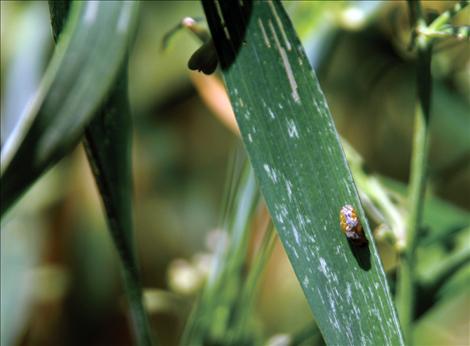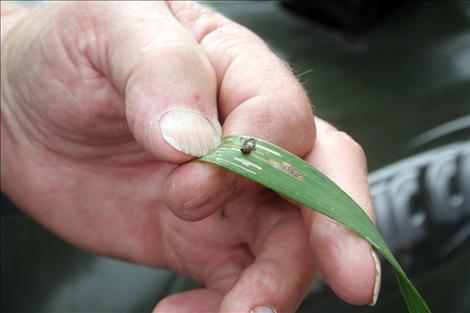Cereal killers
Local farmers battle growing destructive beetle population
Hey savvy news reader! Thanks for choosing local.
You are now reading
1 of 3 free articles.
The population of cereal leaf beetles due to favorable weather conditions exploded this spring, and the infant larva could destroy local cereal grain crops if left unmanaged.
“Any wheat producer should be on the lookout,” Jack Stivers, Lake County Extension agent said. “It’s a predator in our wheat fields. They destroy flag leaf by feeding on it and reducing wheat yield.”
Cereal leaf beetles were spotted on the leaves of cereal grains all over the county but some areas were hit harder than others.
“They are heavily infested around St. Ignatius and west of Ronan at Round Butte,” he said.
Controlling the population can save crops.
“It pays to control it or it’ll reduce yield beyond economic threshold,” he said. “First, scout the field. One (beetle) per plant constitutes control.”
Dr. Michael Ivie, Curator of Entomology at Montana State University, focused his research on the evolution of beetles.
“Evolutionarily they are way tougher than anything we can throw at them,” Ivie said. “You can’t get rid of it. You manage it. At this point in history, they are everywhere.”
The cereal leaf beetle lacks a natural role in local habitats.
“They are not native to the area,” he said. “It’s an invasive species originally from Europe. They’ve been back east for quite a while. They came to Montana in 1989, and they’ve been spreading each year.”
The adults travel by flying and hitchhiking.
“They can get around in vehicles and things like straw,” Ivie said.
The beetle’s comfort level in Lake County has been optimal since last fall.
“If last year had a high population and they had a good winter and the spring is good, they’ll build up,” he said. “They do well with a cool wet spring.”
The adult beetle winters in wood piles, grass, and field debris. In the spring, they come out of hiding, mate, and lay their eggs on wheat, barley, oats and rye, according to an MSU Extension Service report.
The larva uses the leaf to feed and mature before dropping off into the soil. It soon emerges as an adult. The adults eat the leaves but with less destruction.
“They won’t lay another generation of eggs until next spring,” Ivie said.
Ben Selby, a St. Ignatius farmer, discovered the beetles on his wheat.
“My son-in-law noticed the leaves turning brown in spots,” he said. “Your plants turn brown from what they coat themselves with. We noticed that after walking through the field.”
Ivie explained the substance as a mixture of saliva and excrement. They use it to protect themselves from the sun and predators.
“They are hard on the wheat,” Selby said. “We sprayed over a week ago and it seems like it’s doing fine but it doesn’t change the spots. It’s been a bad year for bugs and weeds.”
George Biggs sprayed his St. Ignatius wheat field for the pests, and after checking a few days later declared, “I think we got ‘em.”
Steve Tobol of Ronan was told the beetle population on his farm was high this year.
“I’ll spray next week to kill the larva,” he said. “The last couple of years we haven’t had to spray. It’s like grasshoppers: some years are worse than others. It’s everywhere up here. They are bad in Kalispell, too.”
Tobol noted the economic impact of controlling the beetles wouldn’t be as devastating as losing the entire crop.
“It costs money to control them but if you don’t, you’ll lose more,” he said.


















